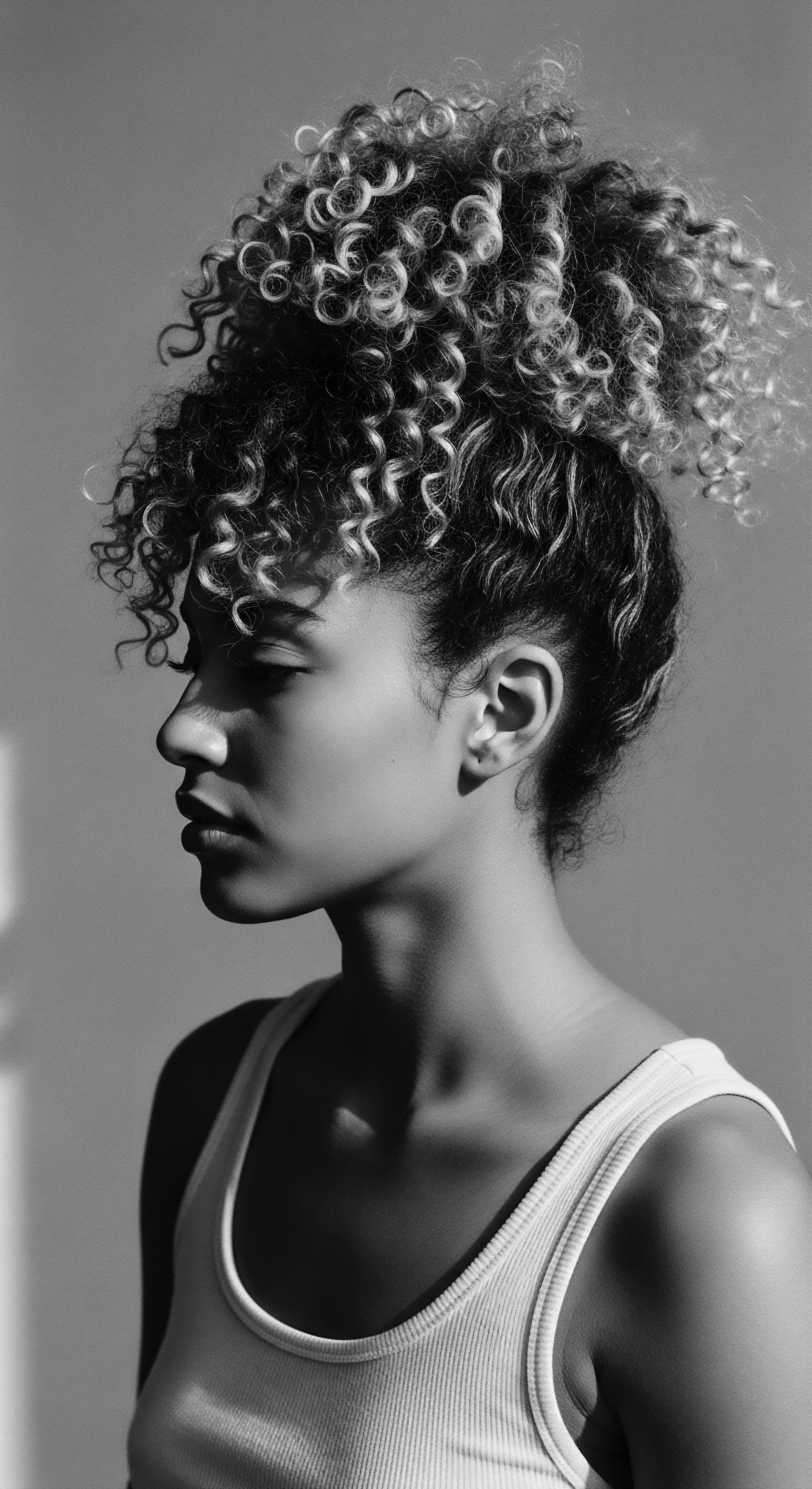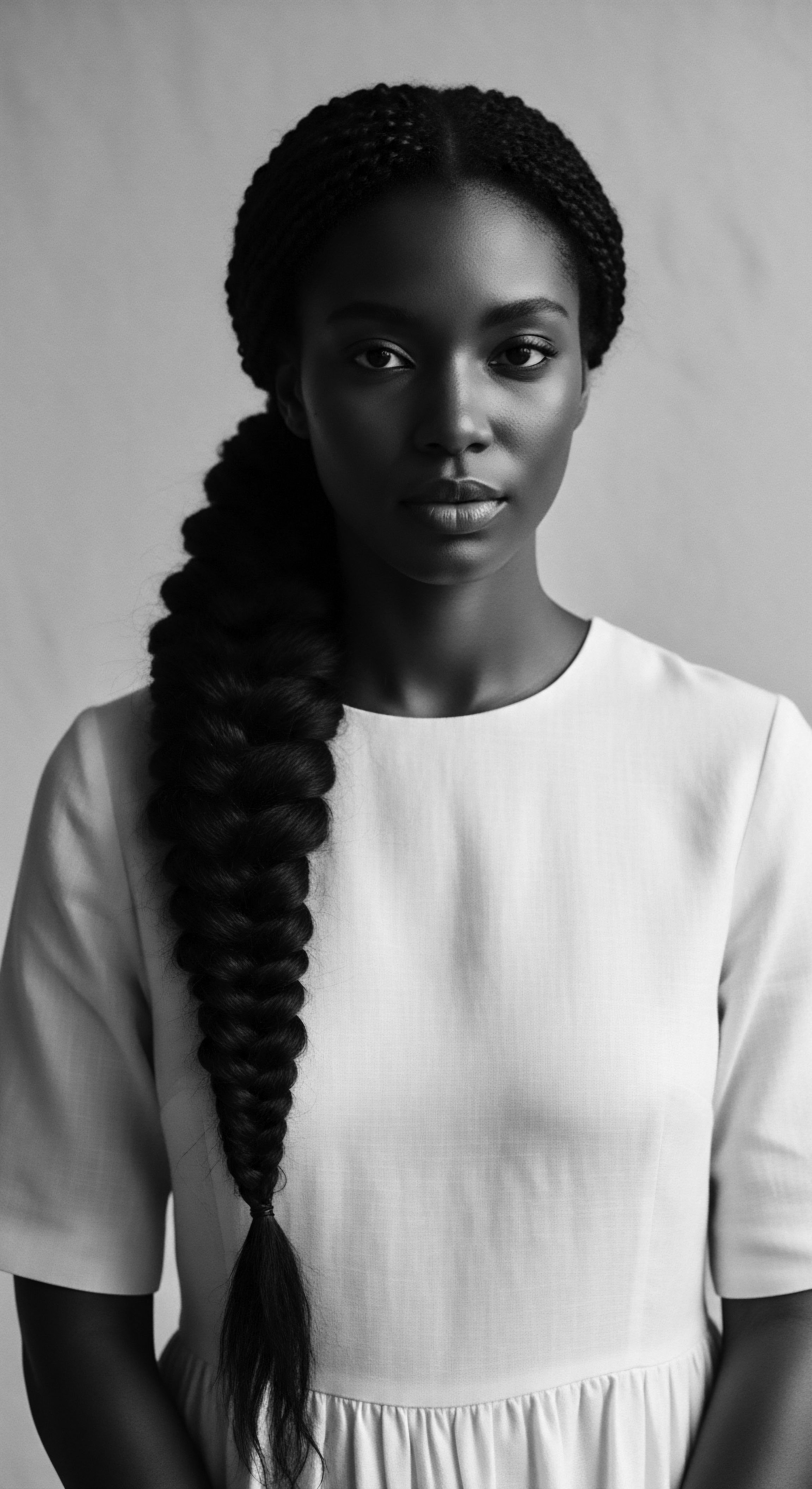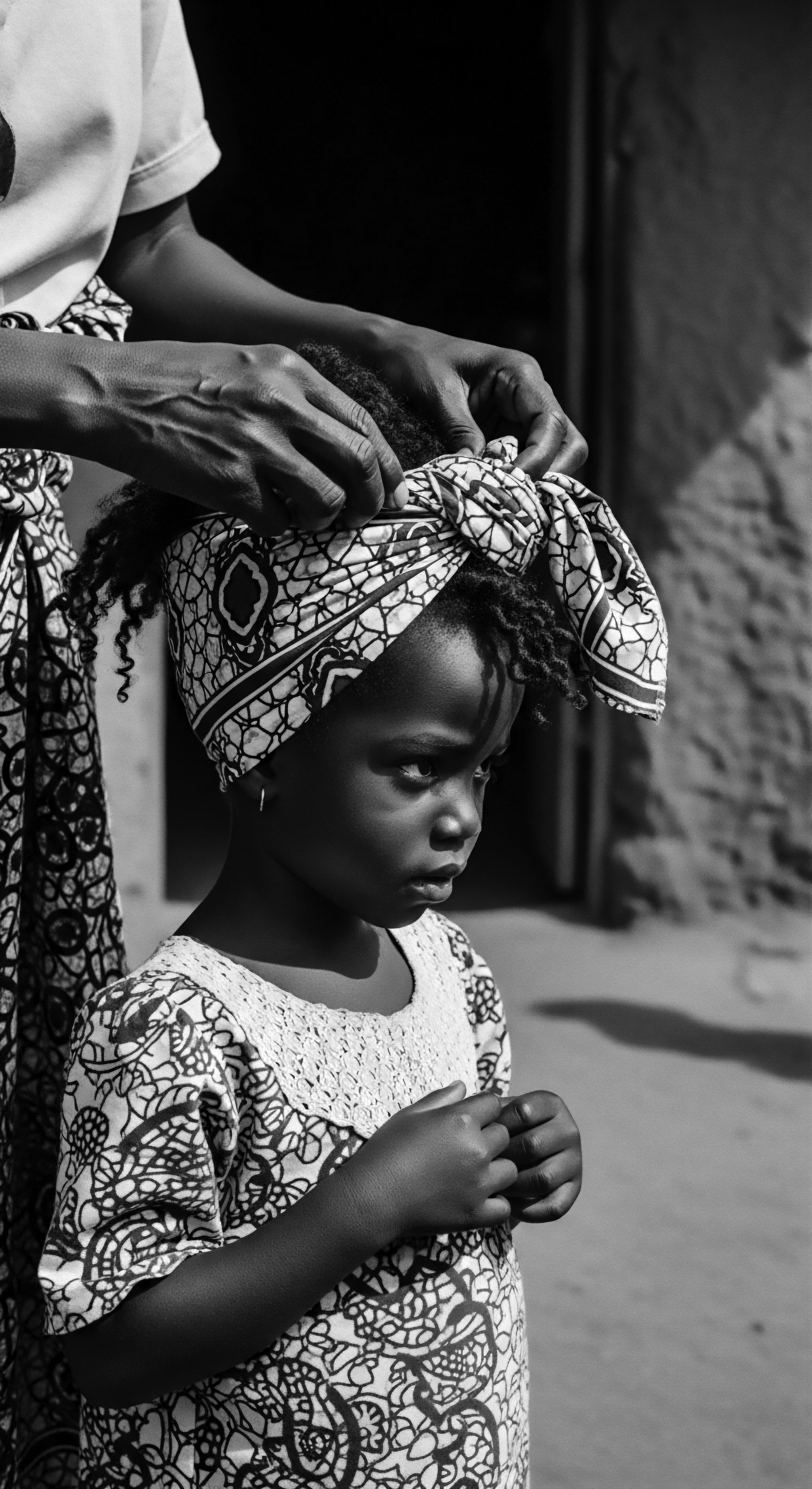
Roots
Consider for a moment the profound memory carried within each coiled strand, within every ripple of hair that graces a diasporic head. It is a memory not solely of genetic inheritance, but of centuries of lived experience, of ancestral wisdom passed down through touch, through communal rituals, and through the very structures of societal order. The story of textured hair, particularly for those of Black and mixed-race descent, is inextricably linked to the intricate dance of identity, reverence, and defiance, a dance often orchestrated by the heavy hand of law. We stand at the precipice of understanding how legislated mandates, sometimes cloaked in the guise of social order, sought to dim the radiant expression inherent in our coils and kinks, yet paradoxically, spurred an even deeper connection to our inherent heritage.
Understanding the impact of historical laws on head covering practices within the diaspora requires a journey into the foundational understanding of textured hair itself, seen through both ancient reverence and modern scientific lens. Our hair, beyond its biological architecture, has always served as a visible lexicon, communicating lineage, social standing, marital status, and spiritual connection in many African societies. When transatlantic crossings severed direct ties to homelands, these traditions found new soil, adapting and persisting even amidst the crucible of forced displacement. The very act of caring for and adorning textured hair became a quiet rebellion, a continuation of selfhood in a world determined to erase it.

The Ancient Language of Strands
Across the vast continent of Africa, prior to the disruptions of colonial rule, hair was never simply an appendage. It was a canvas, a map, a library of ancestral knowledge. Specific styles marked rites of passage, celebrated achievements, mourned losses, and signaled tribal affiliations. The artistry involved in maintaining these complex forms spoke volumes, signifying a deep understanding of the hair’s inherent characteristics.
The texture, the curl pattern, the density—all were revered elements that informed how hair was styled and adorned. These practices were not born of arbitrary whim; they stemmed from an intimate relationship with the hair’s biology and its spiritual significance.
Textured hair in ancestral African communities served as a living archive, conveying intricate details about a person’s lineage and social standing through its deliberate styling.
For example, within many West African cultures, the practice of creating intricate braids and cornrows was a communal affair, often performed by elders, fostering intergenerational bonds and transmitting cultural lore. Such elaborate styles could take hours, sometimes days, to complete, underscoring their profound importance. The knowledge of how to manipulate and care for hair, from cleansing with natural clays to conditioning with shea butter or palm oil, was a precious inheritance. These methods were not just about appearance; they were about preserving the integrity of the hair, acknowledging its inherent resilience, and honoring the spiritual connection it held.

How Did Colonialism Reshape Hair’s Perception?
The arrival of colonial powers brought with it a profound shift in the perception and treatment of textured hair. With the brutal imposition of slavery, African people were stripped of their names, their languages, and their outward expressions of culture. Hair, once a symbol of pride and identity, became a target of erasure. Enslaved individuals often had their heads shaved as a tool of dehumanization, a stark act severing their connection to ancestral heritage.
Yet, even in chains, the spirit of resilience persisted. The practice of wrapping hair, for instance, initially served utilitarian purposes, protecting hair from the elements during arduous labor in fields. Over time, it quietly evolved into a form of covert communication and self-preservation.
The imposition of Eurocentric beauty standards began to define what was considered “acceptable” or “beautiful.” This was a deliberate cultural weapon, designed to internalize inferiority and diminish the inherent worth of African aesthetics. Laws, both formal and informal, would soon codify this discrimination, particularly targeting free people of color whose very appearance challenged the rigid social hierarchies colonial societies sought to establish. These emerging legal frameworks were not isolated incidents; they were calculated strategies to maintain power and control over the burgeoning populations of free Black and mixed-race individuals.
| Ancestral Practice Hair as Identifier ❉ Signified age, social status, marital status, tribal affiliation. |
| Colonial Impact and Response Shaving of Heads ❉ Dehumanization and erasure of identity during enslavement. |
| Ancestral Practice Communal Care Rituals ❉ Strengthened bonds, passed down knowledge. |
| Colonial Impact and Response Utilitarian Head Covering ❉ Protection during labor, later transformed into resistance. |
| Ancestral Practice Natural Product Use ❉ Reliance on shea butter, palm oil for hair health. |
| Colonial Impact and Response Imposition of European Standards ❉ Pressure to straighten hair, internalize foreign beauty ideals. |
| Ancestral Practice Elaborate Styles ❉ Complex braids, adornments with beads, cowrie shells. |
| Colonial Impact and Response Sumptuary Laws ❉ Banning of "excessive" display, forcing coverings to signify low status. |
| Ancestral Practice The colonial era aggressively sought to suppress and redefine Black hair heritage, yet ancestral wisdom persisted, often transforming tools of oppression into symbols of defiance. |

Ritual
The very notion of “ritual” extends beyond a simple sequence of steps; it embodies a deeply ingrained practice, a sacred rhythm that connects individuals to their past, their community, and their inner spirit. In the diaspora, especially concerning textured hair, these rituals of care and styling took on an added layer of meaning, evolving as silent, yet powerful, acts of resistance against oppressive frameworks. It is in this arena that historical laws, intended to diminish and control, were met with an unwavering creative spirit, transforming mandated coverings into vibrant declarations of selfhood and heritage.
One of the most potent examples of such legal impingement and subsequent cultural counter-movement is found in the Tignon Laws of Spanish colonial Louisiana. In 1786, Governor Esteban Miró issued an edict requiring women of African descent, both free and enslaved, to cover their hair with a “tignon,” a scarf or handkerchief, in public. The underlying motivation was deeply rooted in racial anxiety. Free women of color in New Orleans were known for their elaborate hairstyles, often adorned with jewels and feathers, which visually challenged the rigid racial hierarchy and sometimes attracted white men, provoking resentment from white women.
This law aimed to visually mark these women as belonging to a lower social stratum, regardless of their actual freedom or economic standing. (Virginia M. Gould, The Devil’s Lane ❉ Sex and Race in the Early South, 1996)

How Did Women Resist Tignon Laws?
The ingenuity with which these women responded to the Tignon Laws speaks volumes about their resilience and profound connection to their hair heritage. Instead of succumbing to the intended degradation, they transformed the mandated tignon into a striking fashion statement. They sourced luxurious fabrics, such as vibrant Madras cloth, imported from India, which was already deeply significant in Caribbean and West African dress traditions. These cloths, along with ribbons, brooches, and even more jewels, were styled into complex, voluminous headwraps that became symbols of beauty, defiance, and cultural pride.
This creative subversion rendered the law’s intended purpose largely ineffective. The headwrap, instead of signifying inferiority, became a sign of elevated style and unyielding spirit.
The Tignon Law, intended to suppress the visible elegance of Black women’s textured hair, inadvertently ignited a sartorial rebellion that elevated the headwrap to an iconic symbol of cultural pride.
This historical instance highlights a recurring pattern throughout the diaspora ❉ attempts to control Black bodies and appearances often backfired, leading to innovative expressions of self. The practice of head covering, which had deep roots in various West African cultures as a symbol of modesty, spirituality, or status, gained new layers of meaning in the diaspora. It became a protective shield, a canvas for artistry, and a silent language of resistance.

Headwraps as Enduring Legacy
Even after the Tignon Laws ceased to be enforced following the Louisiana Purchase in 1803, the headwrap continued to be a significant part of Black women’s attire. This enduring presence reflects the deep cultural roots of head coverings, predating colonial mandates, and the powerful association they had forged with resistance and self-expression. In the Caribbean, similar sumptuary laws were enacted, and here too, women adapted and re-imagined the headwrap. In places like Dominica, the specific way a headwrap was tied, including the number of peaks, could even convey a woman’s relationship status, drawing from long-standing African cultural cues.
The legacy of these laws and the spirited responses to them reverberates in contemporary styling practices. The modern resurgence of headwraps is a conscious nod to this ancestral fortitude. It is a way of honoring those who, with limited resources and facing immense pressure, chose to adorn themselves not just for aesthetic appeal, but as a deliberate act of reclaiming their agency and celebrating their heritage.
Within the context of textured hair styling, the evolution of techniques and tools often runs parallel to these historical pressures.
- Protective Styling ❉ Styles such as braids, twists, and cornrows, which were historically used for both adornment and practical protection, gained added significance. During enslavement, cornrows were sometimes used to map escape routes, a powerful testament to their hidden utility.
- Natural Styling ❉ Despite societal pressures towards straightened hair, natural textures persisted. The maintenance of coils, kinks, and waves, often hidden under wraps, was a private act of self-care and cultural continuity.
- Traditional Tools ❉ Simple tools like wide-tooth combs, hands for braiding, and natural oils and butters remained central to care, even when external forces sought to impose different standards.
The headwrap, therefore, transcends a simple piece of fabric. It is a chronicle of struggle and triumph, a tangible link to a heritage of creativity and refusal to be defined by imposed limitations. It stands as a powerful reminder that even in the face of restrictive laws, the spirit of textured hair culture found ways to bloom.

Relay
The echoes of historical laws, particularly those impacting head covering practices, continue to reverberate through the holistic care and problem-solving approaches for textured hair in the diaspora. The collective memory of policies designed to demean and control has profoundly shaped not just external appearance, but also the inner landscape of self-perception and cultural connection. This legacy manifests in the careful regimens, the conscious choices of ingredients, and the very philosophy of wellness that surrounds Black and mixed-race hair today, all rooted in an enduring heritage of resistance and self-preservation.
For generations, the deep wisdom embedded in ancestral wellness philosophies offered the primary framework for maintaining hair health, often independent of, or in direct opposition to, prevailing societal norms. These philosophies emphasized the hair’s vitality as a reflection of overall well-being, connecting diet, environment, and spiritual harmony to the strands that sprung from the scalp. When legal strictures like the Tignon Laws attempted to suppress the visual expression of this heritage, the care practices often moved into more intimate, private spaces, deepening their significance as personal rituals of affirmation.

Ancestral Wisdom in Contemporary Care
The foundational principles of hair care within diasporic communities often stem from ancestral knowledge of natural resources. Long before the advent of modern cosmetology, communities harnessed the power of their local flora and fauna to nourish and protect their hair. This historical reliance on natural ingredients directly informs many contemporary holistic hair regimens.
For instance, the use of various plant-based oils and butters for scalp and hair nourishment, a practice common in many West African cultures, gained even greater significance in the diaspora. These traditional ingredients, often applied during meticulous detangling or styling sessions, became acts of care that defied external pressures to conform to European hair ideals.
Such practices, often performed by women for women, established a network of shared knowledge and collective strength. This communal aspect of hair care acted as a counter-narrative to the isolating intentions of oppressive laws.
Traditional hair care, deeply rooted in ancestral knowledge of natural ingredients, transformed into a form of self-preservation and community bonding against historical legal oppressions.

Nighttime Sanctuary and the Bonnet’s Heritage
The concept of nighttime protection for textured hair has deep roots that intersect with historical realities. While not a direct result of specific laws, the vulnerability of textured hair, especially during sleep, meant that protective coverings became a practical necessity. The bonnet, in its various forms, evolved as a crucial tool in preserving delicate curl patterns, preventing tangles, and retaining moisture. This practice carries the quiet echoes of women who, having painstakingly styled their hair or covered it under tignons by day, sought to preserve its integrity and health through the night.
The journey of the bonnet, from utilitarian head covering to a recognized symbol of Black hair care, reflects this enduring heritage. It is a private ritual, one that shields the hair from friction and environmental stressors, ensuring its health and readiness for the next day’s styling. This daily act of protection, passed down through generations, links back to a time when every aspect of hair care was intertwined with resilience.
When considering problem-solving for textured hair, the lens of heritage provides invaluable perspectives. Issues like dryness, breakage, and scalp conditions have been addressed for centuries with traditional methods, often leveraging the very ingredients that were accessible. The historical context of laws that prohibited public display of elaborate styles may have, in some ways, indirectly fueled an even deeper focus on hair health underneath coverings.

How Do Contemporary Practices Connect to Historical Resilience?
The continuing discrimination against textured hair, even after the formal repeal of laws like the Tignon Law, underscores the lasting impact of these historical legal frameworks. A 2019 survey, for example, showed that Black Women Were 80 Percent More Likely Than Non-Black Women to Report Having to Alter Their Hair to Fit in at Work, with natural or braided styles often perceived as “less ready” for professional environments (Pliakas, 2022). This statistic reveals that while overt sumptuary laws may be gone, the underlying biases they codified persist, manifesting in subtle yet pervasive forms of discrimination.
This enduring challenge has led to modern movements, such as the CROWN Act in the United States, which aims to prohibit discrimination based on hair texture and protective hairstyles. These legislative efforts represent a contemporary struggle for the same autonomy and recognition that diasporic women fought for centuries ago through their defiant headwraps. The act of choosing to wear one’s hair in its natural state or in traditional protective styles becomes a powerful statement, linking back to the historical acts of resistance against oppressive decrees.
Our understanding of textured hair has matured, allowing a blend of ancestral wisdom with scientific validation. The science of hair porosity, elasticity, and protein structure now provides explanations for why certain traditional ingredients, like nourishing oils, have been effective for centuries. This synergy allows for a richer, more informed approach to care, one that honors the past while building for the future.
The journey from laws dictating concealment to movements advocating for celebration of natural texture is a testament to the profound strength within textured hair heritage. Each hair care regimen, each protective style, and each head covering chosen today carries within it the memory of past struggles and the promise of a future where beauty is self-defined, unbound by oppressive mandates.

Reflection
When we consider the full sweep of history, particularly the moments where laws sought to define and confine the expression of textured hair through mandated coverings, we uncover a story far richer than mere prohibition. We discover a resilience, a quiet strength that transformed instruments of control into canvases of cultural statement. The journey from the imposition of the tignon to the contemporary advocacy for natural hair freedom across workplaces and schools is a living testament to an enduring heritage.
Each coil and wave tells tales of ancestral mothers who, with deft hands, styled hair not just for beauty, but for survival, for connection, for resistance. The practices of head covering, born out of necessity and tradition, then forced into a symbol of subjugation, were reclaimed with artistry and fierce pride. This narrative stands as a profound meditation on textured hair, its heritage, and its care, presented as a living, breathing archive of human spirit. The soul of each strand truly holds centuries of defiance and self-determination, a luminous legacy for all who cherish its unique beauty.

References
- Byrd, Ayana D. and Lori L. Tharps. Hair Story ❉ Untangling the Roots of Black Hair in America. St. Martin’s Press, 2014.
- Gould, Virginia M. The Devil’s Lane ❉ Sex and Race in the Early South. Oxford University Press, 1996.
- Greensword, Ngandu-Kalenga. “Historicizing Black Hair Politics ❉ A Framework for Contextualizing Race Politics.” Journal of African American Studies, 2022.
- Kynard, Carmen. “Wrapping Our Heads ❉ Archiving Black Women’s Style Politics.” In Education, Liberation & Black Radical Traditions for the 21st Century, edited by Kevin L. Nadal, 2013.
- Pliakas, Toella. “Opinion — Yes, we need a law protecting black people against hair discrimination.” Washington Post, April 11, 2022.
- Robinson, Shana L. The Politics of Black Hair ❉ Narratives of Black Women’s Hair Practices and Their Implications. University of California, San Diego, 2011.
